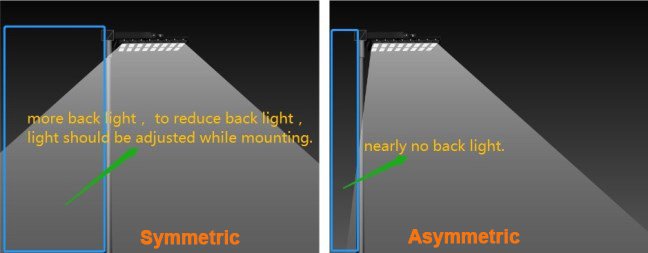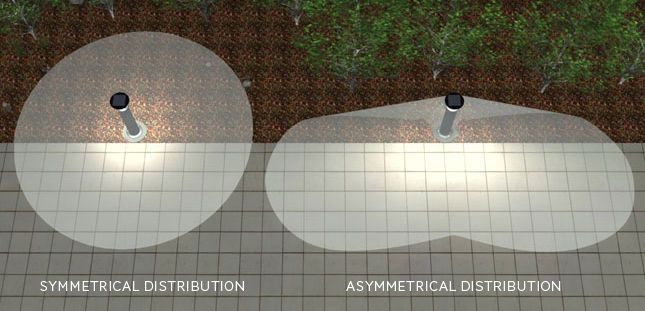When buying a new floodlight we may stumble upon the type of light beam angles: symmetrical or asymmetrical. This technical feature plays a key role in creating the optimum lighting effect in application areas such as stadiums, theaters, sport arenas or streets. In this blog you will be able to learn about the advantages of asymmetrical beams in order to maximize the light output and unlock the full potential of light.
What is the difference between asymmetrical and symmetrical light distribution?
Symmetrical light sources distribute light evenly in all directions. This type of light beam is recommended for both general lighting of large spaces and accent lighting for visual tasks. On the other hand, asymmetrical lighting is ideal for concentrating the light beam in one direction. Therefore, it can be an efficient solution for offices, as it does not produce direct glare that can cause eyestrain with protracted exposure.
Whether it is across a sports field, street, carpark – or even your work desk – light distribution needs to be constant and comfortable on the eyes and directed to illuminate the area it is needed.
As an example, a home reading light shouldn’t affect others in the room watching TV, while providing the right level of light on the page and without too much glare. Similarly, neighbors of a sports field do not want to be kept awake on game nights by unwanted bright light through windows.
The term asymmetric light output is the term to describe a system where light is directed sideways (or in an asymmetric pattern). Symmetrical lighting in comparison spreads the light equally in all directions.
New standards (AS2482:2019) came into effect earlier this year, which makes it mandatory to select lighting products for public spaces such as sports fields that minimize the potentially obtrusive effects of lighting including light spill and glare. This also covers internally and externally illuminated signs, facades or other objects. Some local government authorities have applied restrictions on the frequency of use and hours of operation of outdoor lighting, and on the levels of light spilled beyond the boundaries of the site.
This new standard primarily applies to new lighting installations and affects any project involving outdoor lighting.
Glare occurs when the eye encounters more light than it can cope with. Luminance is light reflected from an illuminated surface, such as a white piece of paper or stainless-steel workbench, which needs to be considered. Similarly, too much contrast or shadow can make it difficult to see properly to complete a task. These are all factors that can be taken into consideration in lighting design to help plan the right product selection and placement.
For area lighting, there are three ways to direct light to where you need it with the latest LED features:
- Select the right beam angle. Fireflier offers a range of beam angles from very narrow to a wider spread of light depending on the lens. This is a pre-set option, so it is important to select the right beam angle for the application when ordering.
- Shields and adjustable brackets can be used to physically adjust the light to minimize glare and direct light to where it is needed. This is particularly important for sports lighting to direct light downwards where players need it, minimizing light spill into the night sky or glare for spectators.
- Intelligent Controls – 1-10V Dimming, DALI, Zigbee and DMX Controls are just some of the features in new lighting models to allow luminaires to be programmed asymmetrically to direct light to where it is needed.
Fireflier has a full range of Sports and Area Floodlights, with both symmetric and asymmetric features. If you are still unsure about the right flood and area light LED options for your project, just email us freely!




